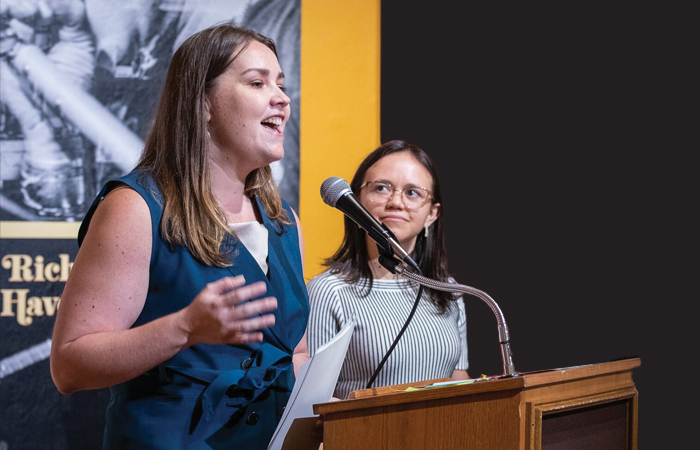
How Virtual Reality Can Make History Accessible
An English PhD student uses virtual reality to highlight marginalized groups and histories
There is a popular saying you’ve probably heard before — “History is written by the victors.” This has tended to mean that the “Great (white) Men” of American history get most of the spotlight, while many other vital stories go unheard. Thanks to a greater awakening in America this is slowly beginning to change, and English PhD student LAKEN BROOKS is doing her part to ensure marginalized voices can be heard — by everyone — through virtual reality (VR) walkthroughs of historic sites and other digital projects that put accessibility first.
Raised by her grandparents in rural North Carolina, Brooks had the importance of education imparted to her early in life. Though her grandfather had no more than a third-grade education, “He always encouraged me to read; he always encouraged me to go to college,” she said. This focus eventually led Brooks to attend Emory College in Virginia where she studied English and received a teaching certificate.
After graduating, Brooks received a Fulbright Student Award which allowed her to participate in an English Teaching Assistant (ETA) Program in Poland, giving her the opportunity to teach at the University of Szczecin and cementing her interest in continuing her studies. After being accepted at UF to pursue her doctorate in English, though, Brooks wasn’t sure what her focus should be.
Coming from a rural location where stereotypes often obscure the real people living there, Brooks had always been interested in finding a way to highlight the histories of marginalized groups, including the LGBTQ community. In particular, she was always drawn to historical buildings as a way to connect the past and present. “It helps you be connected to the people who were there and the things they were seeing every day,” she said.
In highlighting marginalized groups, Brooks believed it was important to make sure those groups — limited either due to money, disabilities or another constraint — could experience these histories themselves. Borrowing a VR camera from UF’s Smathers Library, Brooks began experimenting with the technology. “I love VR tours myself,” she said. “It’s a great way to help people experience and see the world who may not have a lot of money or the capability to travel.”

These digital and VR tours are especially helpful now during this period of online learning, and they are a great way to keep audiences engaged with diverse histories when many museums remain closed for COVID-19.
— Laken Brooks
Brooks first produced a simple 360-degree walkthrough of the Baldwin Children’s Literature Collection at UF that could be watched using VR goggles. Intrigued with the results and the possibilities of the technology, Brooks saw an opportunity. Usually spending her summers with a friend who lives in Washington D.C., she was very familiar with many of the historic sites around the nation’s capital. On a whim, Brooks decided to contact the President Woodrow Wilson House, offering to do a VR walkthrough of the grounds.
During the 2019 winter break, Brooks was treated to a personal, enhanced tour of the empty house, where Woodrow Wilson retired from public life after his presidency concluded in 1921. The guide walked Brooks and her camera through women’s quarters not usually seen on the standard tour. Wilson suffered a stroke midway through his second term in office in October 1919, paralyzing most of his left side and forcing his wife, Edith, into an essential role. As the primary caretaker for the president, she played a vital role managing the office of the presidency, choosing what matters of state were most important to bring to Wilson and, some historians have argued, essentially taking on the role as the first female president of the United States.
After completing and editing the walkthrough, Brooks uploaded it to a YouTube playlist. Using either VR goggles or watching on a computer or mobile device, viewers can look around every corner of each room while receiving a guided tour from Elizabeth Karcher, the Executive Director of the Wilson House. In particular, the walkthrough highlights Edith and the other women who worked at the house, who are oftentimes obscured by history yet who played incredibly important roles in shaping the world.
The pandemic has also shone a spotlight on how these technologies can help organizations during this period of mass closures and social distancing. “Organizations like the National Park Service and National Trust for Historic Preservation have used Google Maps and VR camera tours to highlight people of color who are important in our nation’s history,” Brooks said. “These digital and VR tours are especially helpful now during this period of online learning, and they are a great way to keep audiences engaged with diverse histories when many museums remain closed for COVID-19.”
Seeking to further explore these technologies, Brooks is planning to launch a small digital initiative. “I spent part of my summer in D.C., and I noticed how many local museums are losing precious funding and are at risk of closing down,” she said. “After working with the National Children’s Museum this summer and noticing how their educational content was helping teachers and parents teach students during this difficult time, I wanted to continue this work in Gainesville.”
Brooks plans to create a QR code she will send to teachers and homeschool groups. After scanning the code, users will be taken to a digital exhibit complete with 3D images of items, videos and author statements, she explained, with the goal being to switch these out every few months.
As Brooks continues experimenting with these technologies, her goal remains constant — to make marginalized histories and works accessible for everyone. “I never thought of myself as a technologically savvy person,” she said. “It’s so cool how technology helps connect people across time and space.”


